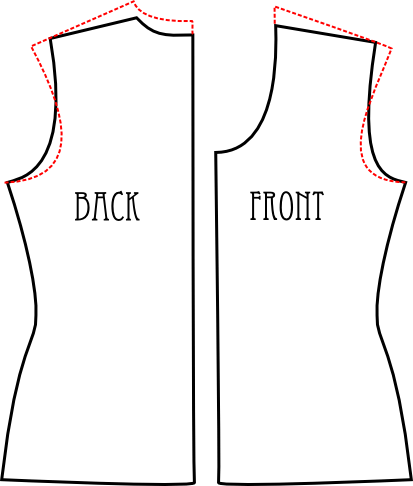Emily of Calico Stretch expressed some curiosity about the square-shoulder alteration in this post. A quick google search turned up plenty of tutorials, but none that actually square the shoulder the way I do.
Which may very well mean that I’m doing it wrong, but I figured I’d throw it out there, anyway.
If you look at the photo above, the need for a square-shoulder alteration doesn’t really jump out at you. I certainly never noticed. But see how high the collar sits at the back of my neck? The fabric is firm enough that it just pushes the collar up, but as soon as I move around it starts bunching and folding back there. I don’t always need it, which is confusing, but when I do, it’s a big (if subtle) improvement.
I tend to square the shoulder by dropping the mid-line—shortening the centre. This is much easier to show than describe, so here’s a quick diagram. The dashed lines represent where I would slash and overlap a pattern, although frequently I just try to incorporate it while I’m tracing off a pattern.
Most of the other methods I’ve run across have you raise the outer edge of the shoulder, rather than dropping the inner edge (eg. Debbie Cook’s excellent little diagram).
So how did I start doing it backwards?
Well, it all goes back to Sherry’s fascinating sway-back analysis. Because while I managed to ignore my square shoulders for years, the annoying lower-back puddling of *every* piece of clothing I have ever owned had always irked me. Anyway, Sherry does an excellent job exploring the ramifications of the sway-back adjustment (not to mention other fit issues that can lead to “sway back” puddling, of which I have at least two), and ends up, in the case of patterns lacking a waist or centre-back seam, basically adjusting the shoulder to shorten the centre back.

My very firstest Lydia, showing the weird tuck it developed above my shoulder. Some of this was armscye issues, but a lot was the slope of the pattern's shoulder seam. Note how the oogliness extends behind the neck. This shirt was one of my few instant wadders*. I gave it to the kids, who promptly "refashioned" it into shreds small enough that I could trash them without too much guilt.
I started out trying this alteration on my knit sloper, and was startled to find that, while it did reduce the swayback puddling a bit, the single biggest effect was to remove the little bulge of extra fabric I always tend to get behind my neck. I had always thought that the solution to this would be to drop the rear neckline (which is what this alteration does), but I had never related that to squaring the shoulders.
I think part of the reason this method works so well for me is I have a short upper body to begin with. The last thing I want to do is increase the distance between armpit and waist, which is what the other method—raising the armscye on the side—would do. Obviously you could then compensate by shortening, but that would be two operations rather than just one. (Frankly, I usually shorten on top of the square shoulder, so I’m not actually saving myself time).
Of course, now that I’ve re-read Emily’s actual question, she was asking more about the armscye differences.
So here’s another diagram, showing (some of) the differences between the two patterns; I ignored the differences in armscye height and waist position/shaping. You can see that, for the same shape of sleeve-cap (which was almost identical between the two patterns), the Renfrew (red dashes) requires less height but more width towards the lower part of the sleeve cap. It would also produce a sleeve that angles down a bit more.
Please note that I am not criticizing Renfrew here—I have no idea which is “better”, if either. I’m just mentioning differences, which may or may not affect things like fit, range of movement, and wrinkling. For example, the downward-sloping sleeve has a somewhat more restricted range of motion than a more outward-pointing sleeve (not a big deal in a knit), but tends to have fewer wrinkles under the arm when the arm is lowered. I’m not even sure how or why the armscye curve on my knit sloper wound up being so shallow.
I’d love to hear anyone else’s thoughts about shoulder alterations and sleeve cap/armscye shaping. I’m no kind of expert—just noting my observations. 🙂
*It often takes me a while—weeks to months—to figure out if an article of clothing is a success or not. Many things I am initially thrilled with end up not being worn, or being worn but not liked, due to some minor quirk of sewing, fit, or styling that I just don’t appreciate right off the bat. I had no such issue with this one: it was awful from the get-go. It (and the four other versions it took me to get the pattern wearable) are the reason I went so hog-wild doing knit pattern comparisons.









